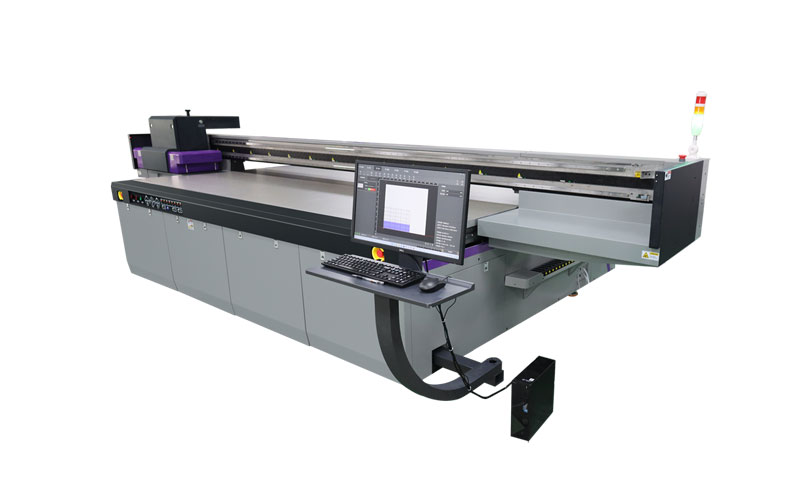UV Flatbed Printer: The Advantages of High-Resolution Printing
UV Flatbed Printer: The Advantages of High-Resolution Printing
In the realm of digital printing, UV flatbed printers have emerged as a game-changer, particularly when it comes to achieving high-resolution prints. These printers have revolutionized various industries, including advertising, packaging, and decorative arts, by offering unparalleled print quality, versatility, and efficiency. This article delves into the advantages of high-resolution printing with UV flatbed printers, exploring how they have transformed traditional printing methods and why they are a preferred choice for businesses seeking top-tier print outcomes.

**1. Understanding UV Flatbed Printers
UV flatbed printers are a type of digital printing technology that utilizes ultraviolet (UV) light to cure or dry ink instantly after it is applied to the substrate. This process allows for immediate fixation of the ink, enabling printing on a wide range of materials, including glass, metal, plastic, wood, and even flexible substrates like leather and fabric. The ‘flatbed’ design refers to the flat surface on which the material is placed for printing, accommodating both rigid and flexible media of various sizes and thicknesses.
**2. The Significance of High-Resolution Printing
High-resolution printing refers to the ability of a printer to produce images with a high number of dots per inch (DPI), resulting in sharp, detailed prints. For UV flatbed printers, this often means achieving resolutions beyond 300 DPI, sometimes reaching up to 600 DPI or more. Such resolutions are crucial for applications where image quality is paramount, such as in fine art reproduction, high-end packaging, and promotional materials that require crisp text and vibrant colors.
**3. Advantages of High-Resolution Printing with UV Flatbed Printers
3.1 Exceptional Image Quality
One of the most prominent advantages of UV flatbed printers is their ability to deliver exceptional image quality. The high DPI ensures that even the finest details are captured, resulting in prints that are virtually indistinguishable from the original image. This level of precision is particularly valuable for applications where accuracy and aesthetics are paramount, such as in architectural renderings, product prototypes, and fine art prints.
3.2 Versatility in Substrate Compatibility
UV flatbed printers can print on a wide array of materials, thanks to the UV curing process that instantly dries the ink. This versatility extends to both rigid and flexible substrates, allowing for creative applications that traditional printing methods cannot match. From printing directly on acrylic signs to creating intricate designs on leather goods, UV flatbed printers offer unparalleled freedom in material choice.
3.3 Enhanced Durability and Scratch Resistance
The UV curing process not only dries the ink instantly but also enhances its durability. The cured ink forms a strong bond with the substrate, making the prints resistant to scratching, fading, and chemical exposure. This durability is particularly advantageous for outdoor applications, such as vehicle wraps and outdoor signage, where prints are subject to harsh environmental conditions.
3.4 Cost-Effectiveness and Efficiency
While the initial investment in a UV flatbed printer may be higher compared to some traditional printing methods, the long-term cost-effectiveness and efficiency make it a worthwhile investment. The ability to print directly onto materials without the need for pre-treatment or post-processing steps significantly reduces labor costs and production time. Additionally, the minimal ink waste and reduced need for maintenance due to the UV curing process contribute to lower operational costs over time.
3.5 Environmental Benefits
UV flatbed printers are more environmentally friendly than many traditional printing methods. The instant curing process minimizes ink evaporation, reducing volatile organic compound (VOC) emissions. Furthermore, the ability to print on demand reduces waste by eliminating the need for large inventories of pre-printed materials. This eco-friendliness is increasingly important as businesses seek sustainable practices to reduce their carbon footprint.
3.6 Creative Flexibility and Customization
High-resolution UV flatbed printers offer unparalleled creative flexibility and customization options. Designers and printers can experiment with various substrates, ink colors, and textures to achieve unique visual effects. This versatility allows for the creation of personalized products and promotional materials that stand out in a competitive market.
**4. Applications of High-Resolution UV Flatbed Printing
The advantages of high-resolution UV flatbed printing are evident in a wide range of applications:
- Advertising and Signage: High-quality prints for billboards, banners, and point-of-purchase displays.
- Packaging: Customized packaging with intricate designs and vibrant colors for luxury products.
- Decorative Arts: Fine art reproduction, home decor items, and personalized gifts.
- Industrial Manufacturing: Prototyping, product labeling, and functional part marking.
- Automotive and Transportation: Vehicle wraps, decals, and interior trim components.
**5. Conclusion
UV flatbed printers with high-resolution capabilities have transformed the printing industry by offering unparalleled image quality, versatility in substrate compatibility, enhanced durability, cost-effectiveness, environmental benefits, and creative flexibility. As businesses continue to seek innovative ways to enhance their products and promotional materials, UV flatbed printing stands as a testament to the power of digital technology in achieving exceptional results. Whether for commercial or artistic purposes, the advantages of high-resolution UV flatbed printing are undeniable, making it a valuable tool for any business striving for excellence in print output.
